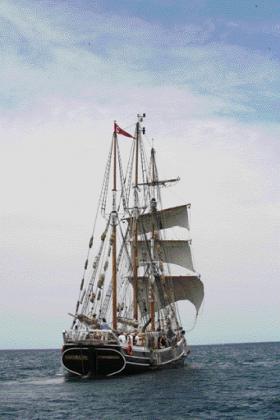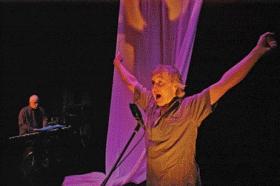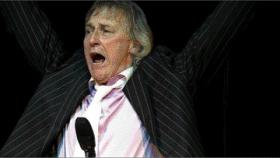Theatre Eye
Published in 18th-19th Century Social Perspectives, 18th–19th - Century History, General, Issue 6 (Nov/Dec 2008), Reviews, Volume 16
The whaling ship Catalpa—purchased by John Devoy and James Reynolds of Clan na Gael for the purpose of liberating Fenian prisoners in Fremantle, Western Australia—as depicted by RTÉ’s ‘Hidden History’ documentary on the subject broadcast in autumn 2007. (Crossing the Line Films)
Catalpa
Performed and directed by
Donal O’Kelly
Music by Trevor Knight
Axis Theatre, Ballymun,
18 September 2008
Running Beast
Performed and directed by
Donal O’Kelly
Music by Michael Holohan
National Concert Hall,
Dublin, 11 May 2008
Donal O’Kelly’s highly individual approach to the theatre involves adramatic reworking of key themes and events in Irish history. In thetwo plays under review Kelly’s work takes the form of a sustaineddramatic monologue with minimal props and costumes—a hat, a piece ofcloth—with a musical accompaniment. Both pieces have been criticallyacclaimed, partly no doubt on the strength of O’Kelly’s bravuraperformances and also because of his assured experimentation with theform, the exciting way he combines mime, music and monologue to weavehis pieces together. These are noteworthy in themselves, but what makesthem most interesting in the present context is O’Kelly’s choice ofthemes from Irish history and his unusual and original way ofapproaching these historical themes. On one level, O’Kelly is aconsummate storyteller, using his medium to animate or dramatise anarrative. Yet he is also aware of the way in which art and narrativeinteract to produce something that is quite different from a historicalrepresentation.
Catalpa, which won a fringe award at the Edinburgh Festival on itsdebut in 1996, is based on the daring rescue of six Fenian prisonersfrom Fremantle penal colony in Western Australia in April 1876. Theescape was masterminded in the United States by John Devoy and JamesReynolds of Clan na Gael. A whaling ship was purchased, commanded by aNew Bedford whaling captain, George Smith Anthony, to sail to Australiaunder cover of a whaling expedition and spring the Irish prisoners.Meanwhile, John Breslin, a Fenian agent posing as a businessman,organised the escape of the prisoners from Fremantle to a rowing boat,which conveyed the six Fenians onto the Catalpa. Despite appallingweather and with a British naval ship in hot pursuit, Anthony succeededin evading capture and reached New York harbour safely by 19 August1876.

Performer/director Donal O’Kelly mimics the Catalpa under sail. His work takes the form of a sustained dramatic monologue with minimal props and costumes. Trevor Knight (left) provides the music.
Eventhe bare bones of the story are brimming with dramatic potential, butit was interesting to see how O’Kelly responded to the challenge.Unlike his Running Beast, based on the career of Hugh O’Neill, O’Kellywas more interested in the epic possibilities of the Catalpa rescue andits universal resonance and only secondarily concerned with thepolitical context. Indeed, the real hero of the piece is theMassachusetts whaling captain George Anthony, whose 1897 account of theexpedition is the major source of information. The obvious parallelswith Herman Melville’s epic Moby Dick were clear in the play. Thepursuit and killing of the whale in Catalpa evoked a spectrum of grandthemes that transcended the historical moment. Catalpa becomes a kindof epic tale of the struggle for freedom generally rather than an epicor episode in the history of the Irish freedom struggle. Anthony, thehero, was marginal to the politics of the story, despite the fact thathe is its chief protagonist. These layers of meaning may partly accountfor the play’s appeal to a much wider audience. The ironies inherent inO’Kelly’s oblique perspective on the heroic tale offer much widerpossibilities for the treatment of history in the theatre than a morestraightforward narrative might have done. The transcendentpossibilities explored in Catalpa are also appropriate to the theatre’sgreater ability to handle really grand human themes on the level ofmyth or epic rather than on the level of history. The ironic element,centring on the accidental heroism of the innocent New EnglanderAnthony, also works on a more political level, in that it begsquestions about the historical truth of these events. Is this perhaps areflection of the more complex attitudes towards history and heroismwhich were current in the year the play was first performed and whichhave dominated ever since?

In Running Beast O’Kelly’s Hugh O’Neill, dressed in a pinstripe suit, a sort of Arturo Ui or fictionalised Haughey à la Sebastian Barry, was clearly designed to provoke reactions in the audience.
Irony and virtuosity were also present in abundance in the productionof O’Kelly’s treatment of the life of the Great O’Neill, Running Beast,in May. The dramatic irony here was laid on rather thickly in thepresentation of O’Neill as a powerful politician in retirement,reliving the excitements of his career from the perspective of ultimatefailure and exile. O’Neill, dressed in a pinstripe suit, a sort ofArturo Ui or fictionalised Haughey à la Sebastian Barry, was clearlydesigned to provoke reactions in the audience. Here O’Kelly wasreminiscent of the Brian Friel of Translations and, more especially,Making History as much as the author of Catalpa. The risks areproportionately greater. Some critics have wondered whether this kindof play is dangerously verging on kitsch, or indeed whether itsacrifices art for didacticism. The audience is confronted with aversion of events mediated in various ways, as in the programme notes,where an expert provides a historiographical essay quite detached fromthe play itself. Purists will also wonder about the language of thisexercise. To make O’Neill fit the pinstripe suit, he must use alanguage divorced from the real languages of the past to make him seema real person. Despite these problems Running Beast was a memorableexperience. I encountered at least one academic economist whosecuriosity about early modern Ireland had been stimulated by theexperience. O’Kelly’s own virtuosity and energy in both plays commandsrespect, although one wonders whether anyone else could possiblyrecreate his success with the same material. He is to be commended fortaking risks, and often succeeding against the odds, in what has oftenbeen a difficult encounter between drama and history in Ireland.
Eamon O’Flaherty lectures in history at University College Dublin.
















